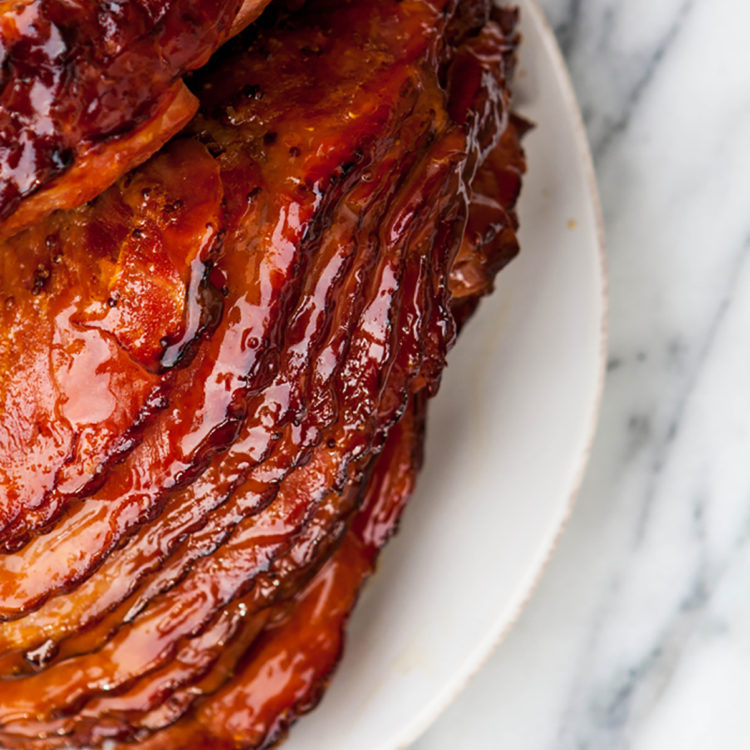
How to Freeze Ham (Fresh or Cooked)
Don’t let any of your holiday ham go to waste! In this guide, I explain How to Freeze Ham, including both the meat and the ham bone. Use frozen ham in soups, casseroles, sandwiches, and more!
This post may include affiliate links. As an Amazon Associate and member of other affiliate programs, I earn a small commission from qualifying purchases.
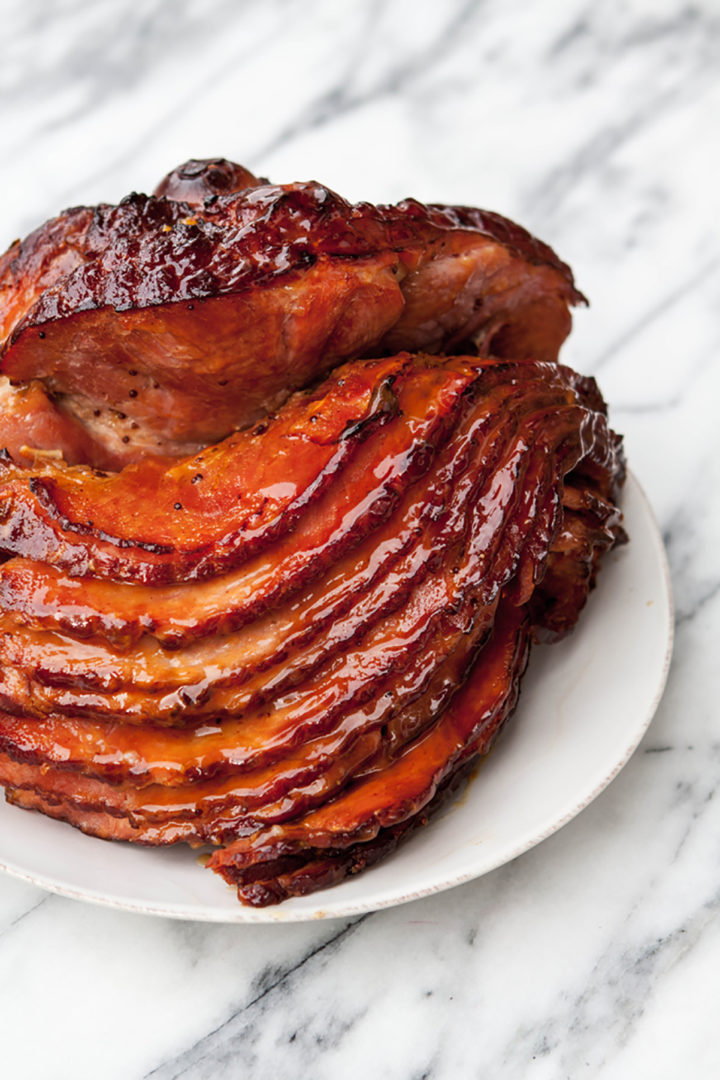
Holiday Ham Freezes SO Well!
If you buy a ham for the holidays — be it Easter, Thanksgiving, or Christmas — chances are you’ll wind up with leftovers.
After spending all that time, energy, and money making our favorite glazed holiday ham, the last thing I want to do is throw any of it away. My solution? Freezing the leftover ham!
✔ No Food Waste: Freezing ham is a great way to store it for future recipes and means we can look forward to leftover ham sandwiches, ham soup, and more throughout the winter.
✔ Perfect After Thawing: Cooked ham doesn’t change texture when frozen, nor does it dry out.
✔ No Special Equipment Required: If you don’t have a fancy vacuum sealer setup, you can still freeze your holiday ham using zip-top freezer bags. So easy!
Enjoy!
-Katie
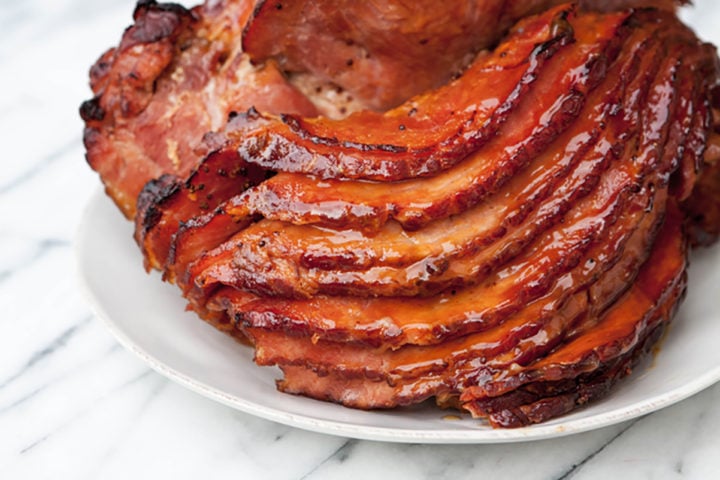
Equipment You’ll Need
- Large knife and cutting board — For removing the ham from the bone and then cutting it into slices or cubes.
- Vacuum sealer and bags (optional) — Vacuum seal bags are the best way to prevent frozen ham from developing freezer burn, but if you only have regular zip-top freezer bags they’ll work too!
- Zip-top freezer bags — It’s important that you use freezer bags and not regular zip-top bags so the ham doesn’t develop freezer burn.
- Aluminum foil or plastic wrap — I wrap smaller portions of ham in foil or plastic wrap before sealing in a larger freezer bag. This makes thawing smaller quantities of ham easier later on and also is an added protection against freezer burn.
- Measuring cup — I like to divide the ham into 1-cup portions so I can thaw exactly what I need for future recipes.
- Labeling supplies — Always label frozen ham with the date you made it, as well as how large the portions of ham are (I recommend freezing in 1-cup portions or in quart-sized bags).
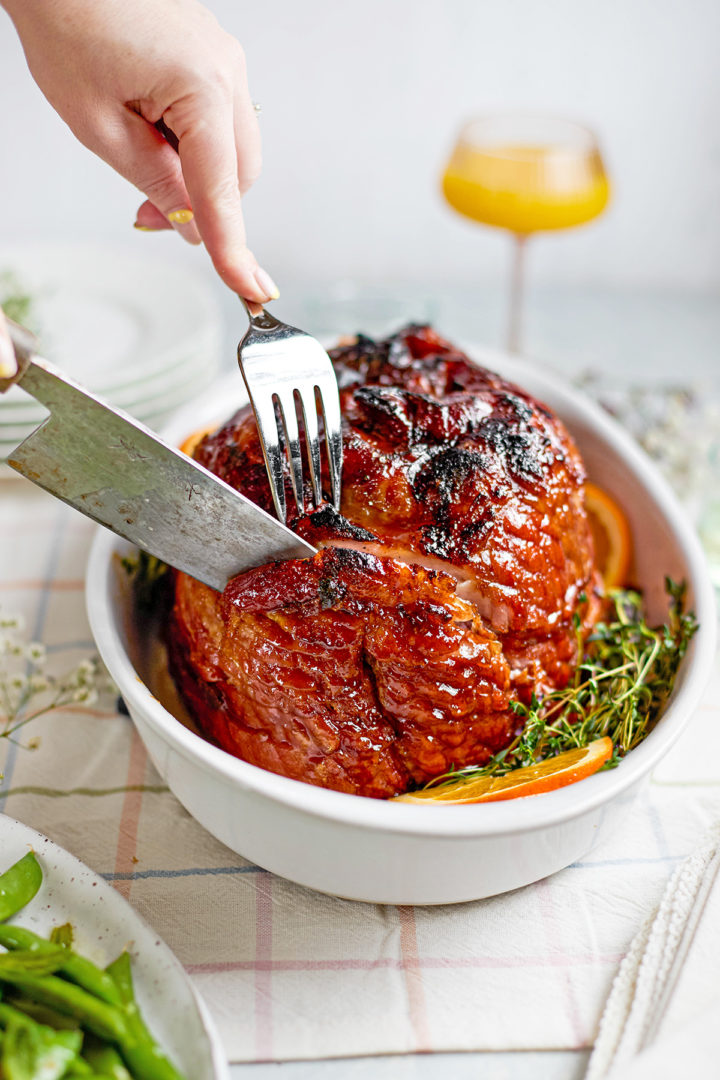
How to Freeze Ham Whole, in Slices, or Cubed
Option 1: Freezing a Whole Spiral Ham (Fresh or Cooked)
A spiral ham can be frozen fresh (raw) or after it’s been cooked. This freezing method also applies to ready-to-eat / pre-cooked hams that you’ve not yet cooked yourself.
The only time I freeze a whole ham is if I’ve bought it well in advance of a holiday to take advantage of a sale price at the grocery store. I prefer freezing whole hams prior to cooking them.
With that being said, I almost never freeze a whole ham after it’s been cooked simply because they take up so much space in the freezer!
- If you already cooked the whole ham, let it cool completely before beginning the freezing process. Otherwise you can begin with a fresh or ready-to-eat cooked ham.
- Wrap the entire ham with plastic wrap and / or aluminum foil. This will help prevent freezer burn.
- Seal the ham in a vacuum freezer bag OR a regular zip-top freezer bag. Try to remove as much excess air as possible.
- Label, date, and freeze the ham for up to 3 months.
Option 2: Freezing Ham in Slices or Cubes (Recommended)
If you plan on freezing leftover ham, this is the method I recommend using. I suggest freezing sliced or cubed ham in 1-cup measurements for easier portioning in the future. Or freeze the ham in quart-sized freezer bags — either increment works for freezing smaller portions of ham!
Freezing ham in 1-cup or quart-sized increments means you can thaw smaller quantities in the future for using in soups, casseroles, sandwiches, and more.
- After cooking the ham, let it cool completely before beginning the freezing process.
- Depending on how you plan on using the frozen ham, either cut it into slices or 1-inch cubes. I recommend slices if you plan on eating the frozen ham in sandwiches or 1-inch cubes for soups and casseroles.
- Divide the prepared ham into 1-cup (8 ounces) portions. This will make it easier to thaw the exact amount of ham you need for future recipes.
- Wrap each 1-cup portion of ham in plastic wrap or aluminum foil. This makes removing the smaller portions of frozen ham easier and is also extra insurance against freezer burn. Alternatively, you can portion the ham into quart-sized freezer bags if 1-cup increments are too small for your needs.
- Seal the foil-wrapped portions of ham in a gallon-sized freezer bag or freezer-safe container.
- Label, date, and freeze the ham for up to 3 months.
Bonus: Freezing a Ham Bone
Do NOT throw away that ham bone! The ham bone is packed with flavor and can be used to make soup stock, or it can be added directly to a pot of ham soup (any kind) and it simmers with the other ingredients to make the richest soup ever.
Note that the ham bone can be refrigerated for up to five days in the fridge before it needs to be frozen.
- After removing as much of the meat from the ham bone as possible, seal the bone in a freezer bag or freezer-safe container. (Or, seal within a vacuum freezer bag to keep the bone for even longer.)
- Label, date, and freeze the ham bone for up to 1 year.
- When ready to use, thaw overnight in the fridge and proceed with the recipe as written.
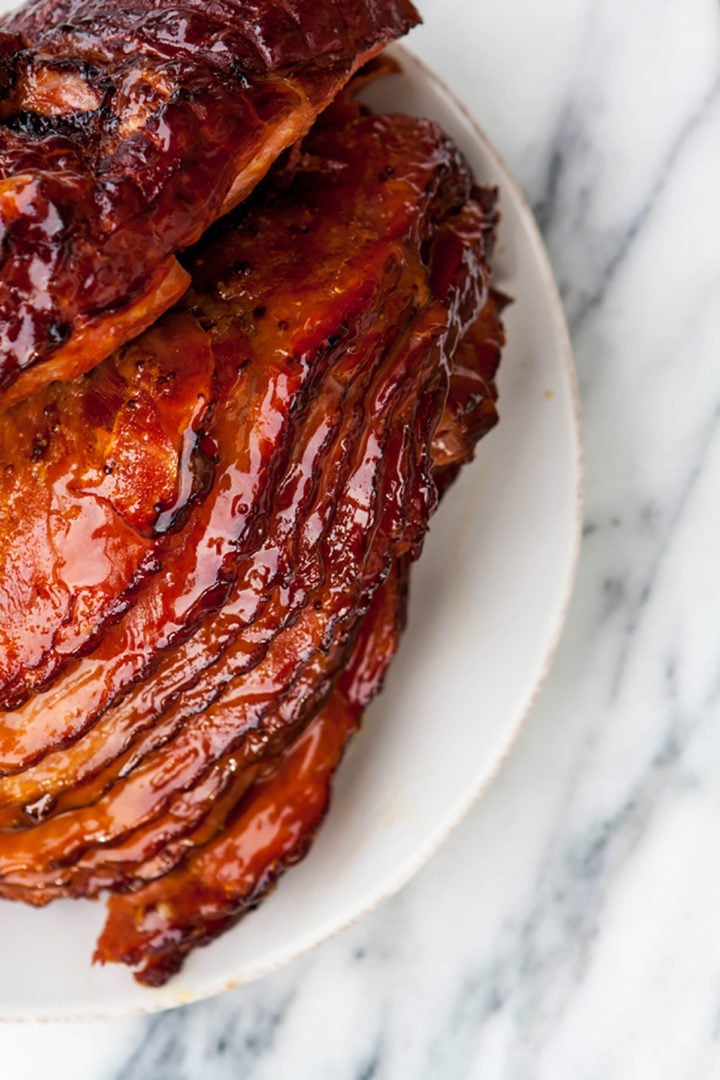
Tips for Freezing Ham
- Package the ham in a timely manner — After cooking the ham in the oven or slow cooker, it can safely sit out on your counter for 2 hours before it needs to be refrigerated or frozen. Refrigerated ham is good for about 5 days before it must be frozen.
- Remove as much air as possible from the bags — Excess air in the freezer bags is what causes freezer burn over time. Press as much air as possible from the bags, or suck it out using a straw.
- Label and date the ham — Be sure to include the amount of meat contained in the bag for easy recipe reference.
- Use within 2 to 4 months for best results — Frozen ham technically shouldn’t go bad, but over time it will inevitably dry out or develop freezer burn. Using vacuum seal freezer bags extends ham’s shelf life even further than 4 months, but you’ll still want to enjoy the frozen ham in a timely manner.

Thawing Instructions
I recommend thawing frozen ham using the same methods you’d employ to defrost any type of frozen meat. You have three options for defrosting frozen ham:
- In the fridge overnight — This could take longer depending on the quantity of ham you’re defrosting.
- Sealed in a zip-top bag and submerged in cold tap water — You’ll need to change the cold water every 30 minutes until the ham is thawed. A whole frozen ham will take approximately 30 minutes per pound to defrost when thawing in cold water whereas smaller portions of sliced or cubed ham will thaw much more quickly.
- In the microwave at 30-second intervals — This works well for smaller portions of cubes or sliced ham, but this is NOT recommended for defrosting a whole ham (the ham would dry out on the outside while the inside would remain frozen).
Katie’s Tip: A whole frozen ham will take anywhere from 4 to 6 hours per pound to defrost. I suggest defrosting a frozen ham in your refrigerator for 2 to 3 days before cooking it.
Frozen ham slices will take much less time to defrost than a whole ham. You can thaw ham slices overnight in the fridge, or submerge them in a sealed plastic bag in COLD tap water for 30 minutes to 1 hour (it depends on the quantity and thickness of the slices).
Reheating Instructions
Reheating frozen ham is very easy! After thawing the ham as instructed in the section above reheat it using one of the following methods:
- In a slow cooker — Recommended for large quantities or ham or a whole ham. A large, 8-pound spiral ham will take 8 hours to reheat on low while smaller portions or ham will take much less time to reheat.
- In the oven — Place the ham in a baking dish and cover with foil to prevent it from drying out. Bake for 10 minutes per pound of ham at 325ºF.
- In the microwave — Only recommended for individual servings of ham. Heat for 30-second intervals until warm.
Katie’s Tip: You can cook a whole ham from frozen without thawing it – just note that it will take 50% longer to cook through. You can also freeze a ham, thaw it, and then cook after having been frozen. This is the method I recommend so you don’t have to cook the ham for so long and potentially dry it out!
Recipes to Make with Leftover Ham
Stay Inspired in the Kitchen!
Want more delicious recipes, kitchen tips, and meal inspiration? Sign up for the Good Life Eats Newsletter and get:
✔ Tried-and-true recipes—from quick weeknight meals to special occasion favorites.
✔ Seasonal meal ideas—helping you make the most of fresh, in-season ingredients.
✔ Time-saving kitchen tips—boosting your confidence and creativity in the kitchen.
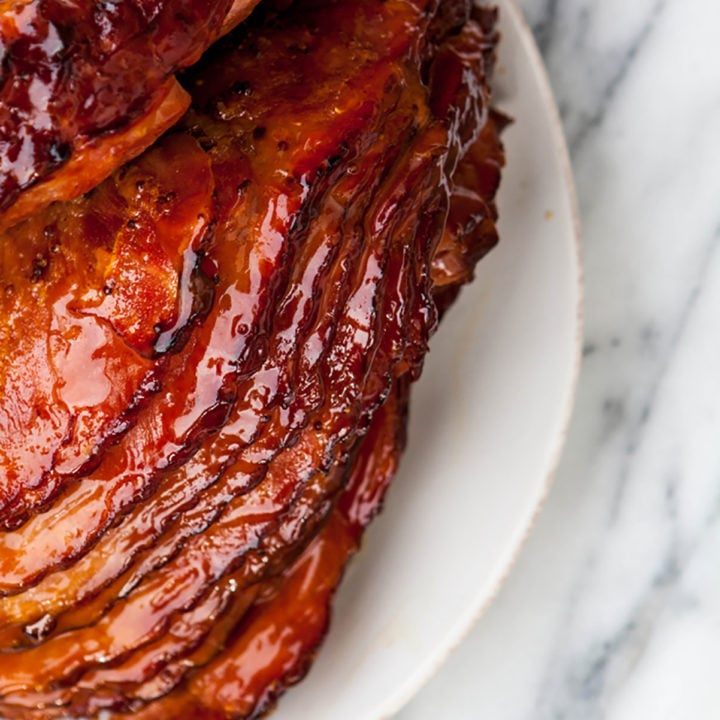
How to Freeze Ham
Don’t let any of your holiday ham go to waste! In this guide, I explain How to Freeze Ham, including both the meat and the ham bone. Use frozen ham in soups, casseroles, sandwiches, and more!
Ingredients
- Cooked or fresh ham
Instructions
Freezing a Whole Ham (Fresh or Cooked)
- If you already cooked the whole ham, let it cool completely before beginning the freezing process. Otherwise you can begin with a fresh or ready-to-eat cooked ham.
- Wrap the entire ham with plastic wrap and / or aluminum foil. This will help prevent freezer burn.
- Seal the ham in a vacuum freezer bag OR a regular zip-top freezer bag. Try to remove as much excess air as possible.
- Label, date, and freeze the ham for up to 3 months.
Freezing Ham in Slices or Cubes (Recommended)
- After cooking the ham, let it cool completely before beginning the freezing process.
- Depending on how you plan on using the frozen ham, either cut it into slices or 1-inch cubes. I recommend slices if you plan on eating the frozen ham in sandwiches or 1-inch cubes for soups and casseroles.
- Divide the prepared ham into 1-cup (8 ounces) portions. This will make it easier to thaw the exact amount of ham you need for future recipes.
- Wrap each 1-cup portion of ham in plastic wrap or aluminum foil. This makes removing the smaller portions of frozen ham easier and is also extra insurance against freezer burn. Alternatively, you can portion the ham into quart-sized freezer bags if 1-cup increments are too small for your needs.
- Seal the foil-wrapped portions of ham in a gallon-sized freezer bag or freezer-safe container.
- Label, date, and freeze the ham for up to 3 months.
Freezing a Ham Bone
- After removing as much of the meat from the ham bone as possible, seal the bone in a freezer bag or freezer-safe container. (Or, seal within a vacuum freezer bag to keep the bone for even longer.)
- Label, date, and freeze the ham bone for up to 1 year.
- When ready to use, thaw overnight in the fridge and proceed with the recipe as written.
Notes
Please referece the post above this recipe card for detailed instructions on how to thaw and reheat frozen ham.
Try Freezing Your Holiday Ham!
Did You Try This? I’d love to hear how it turned out! Leave a comment and a review below—your feedback helps others and makes my day.
Share Your Creations!
If you took a photo, tag me on Instagram @goodlifeeats and use #goodlifeeatsrecipes—I’d love to see what you’re cooking up in your kitchen!





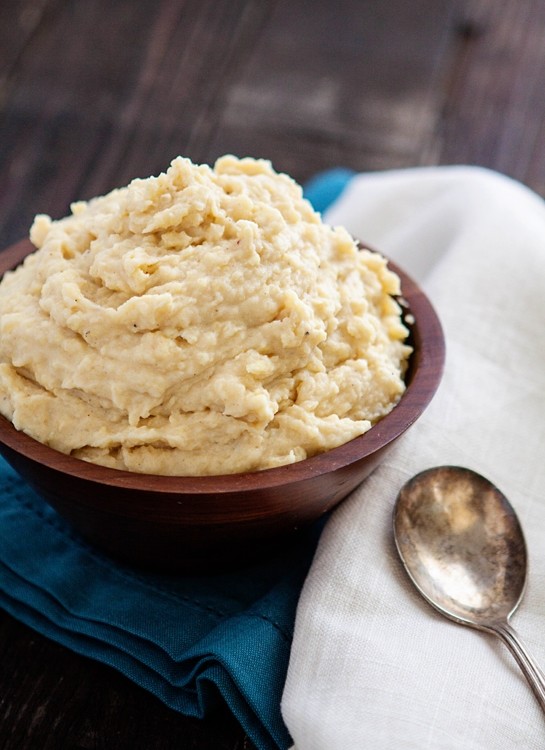




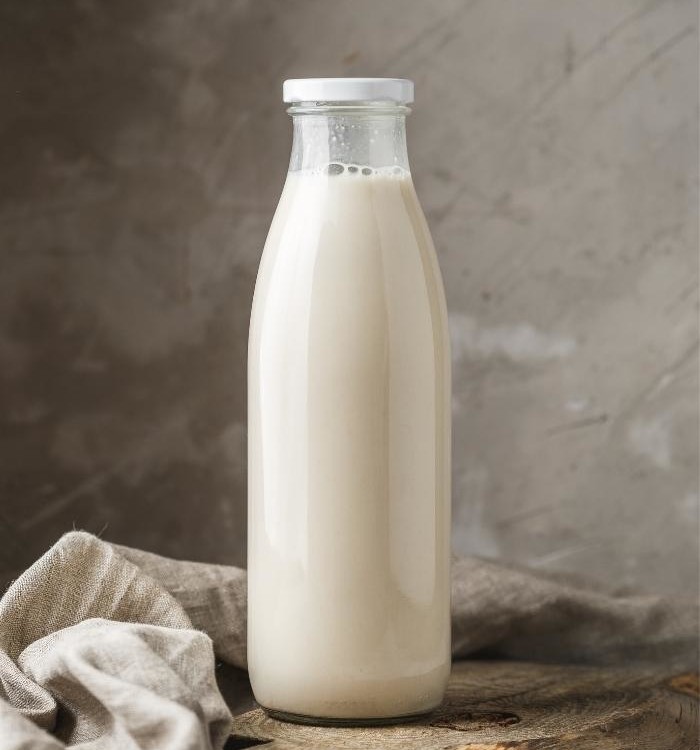
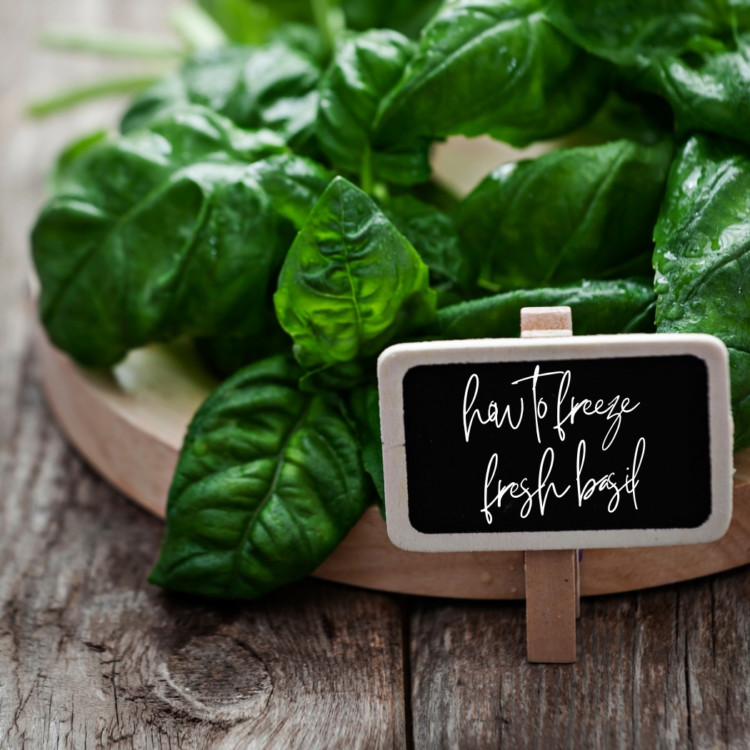



Leave a Comment